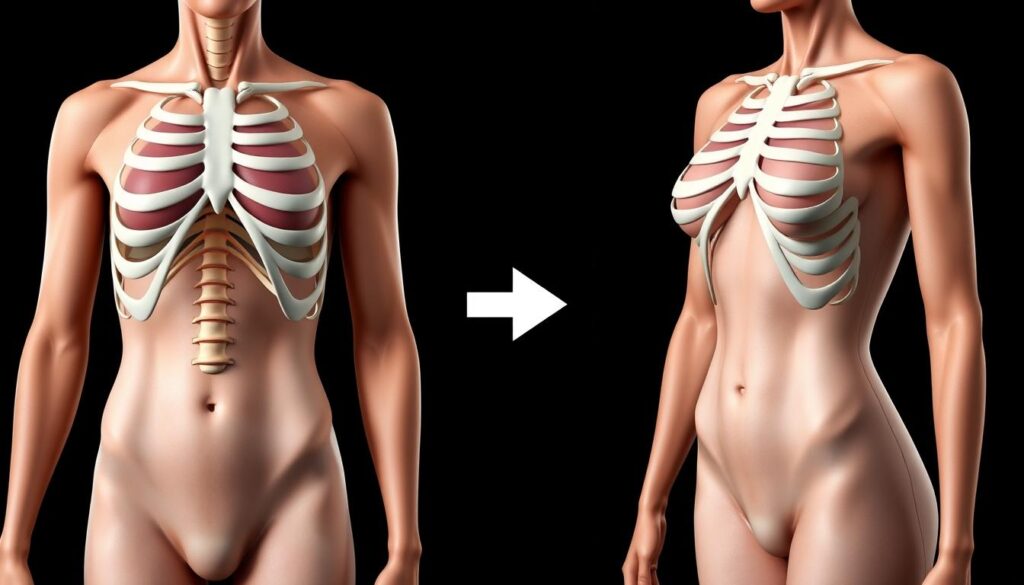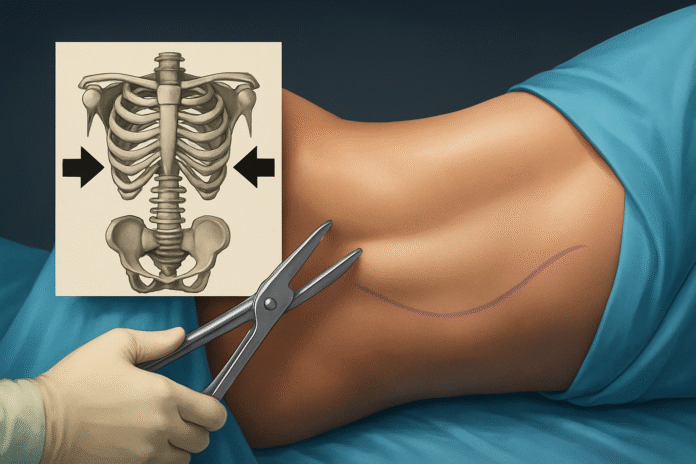In the ever-evolving world of body contouring, one trend is grabbing attention for its dramatic results and raising eyebrows for how it’s done: reshaping the waist by altering the ribs.
While it may sound extreme, there are now two distinct options: rib removal and the newer, less invasive rib remodeling. If you’re curious about the science behind the curves or wondering if it’s safe? Here’s everything you need to know.
Rib Removal: The Traditional, More Invasive Option
Rib removal surgery, also called costectomy, is the surgical removal of one or more ribs, usually the 11th and 12th “floating ribs.” This approach has been historically used for both cosmetic and medical purposes.

Why Do People Get Their Ribs Removed?
-
To create a narrower waist or hourglass figure
-
To address chronic pain or rib abnormalities
-
To improve access to internal organs during complex surgeries
According to Dr. Parikh, a board-certified plastic surgeon,” Rib removal is a complex and permanent surgery. While it can dramatically change the body’s silhouette, it comes with more recovery time, visible scarring, and greater risks.”
How It Works
Rib removal is performed under general anesthesia. The surgeon makes incisions along the lower back or under the rib cage, detaches the target ribs, and removes them entirely. The operation can take several hours, depending on the number of ribs removed.
Recovery and Risks
-
Recovery time: 4–6 weeks
-
Common side effects: Pain, swelling, bruising
-
Risks: Infection, nerve damage, scarring, and loss of ribcage stability
-
Aftercare includes pain medication, compression garments, breathing exercises, and limited physical activity for at least four weeks.
Rib removal offers dramatic and permanent results—but it’s not reversible, and risks are real. Think carefully and always consult a certified surgeon.
Rib Remodeling: The New, Less Invasive Trend

Rib remodeling is a newer procedure that doesn’t remove the ribs but reshapes and repositions them. It’s seen as a safer, quicker, and less painful alternative, especially for patients seeking a more contoured waistline without major surgery.
“Patients want that ‘snatched’ waist, but without removing any bones,” says Dr. Josef Hadeed, a board-certified plastic surgeon. “Rib remodeling offers that middle path.”
(source-plasticsurgery.org)
How Rib Remodeling Works
-
Two tiny incisions are made on the lower back.
-
Surgeons gently score the last three ribs and apply pressure to reshape them.
-
No ribs are removed.
-
The ribcage remains intact, preserving its protective function.
The procedure takes under an hour under general anesthesia and leaves minimal to no scarring.
After surgery, patients must wear a medical corset 24/7 for three months. This helps the newly shaped ribs set in place and further slims the waistline.
“You see results immediately, but the corset is key to locking them in,” says Dr. Andre Marshall. “If you’re not committed to wearing it, don’t do the procedure.” (source-plasticsurgery.org)
Who’s It For?
Ideal candidates are:
-
Under 45 years old
-
BMI below 30
-
Healthy, active lifestyle
-
Looking for waist contouring without major surgery
It’s especially popular among women and transgender patients seeking a more dramatic silhouette.
Rib Removal vs. Rib Remodeling: Quick Comparison
| Feature | Rib Removal | Rib Remodeling |
|---|---|---|
| Ribs removed? | Yes | No |
| Scarring | Moderate | Minimal |
| Recovery Time | 4–6 weeks | 2–3 weeks |
| Risk Level | Moderate to High | Low (with trained surgeon) |
| Requires Corset | Optional | Mandatory (3 months) |
| Pain | More intense | Mild to moderate |
| Results | Permanent | Long-lasting |
Both rib removal and rib remodeling can reshape your waist, but they’re very different surgeries with different risks and recovery paths. Rib removal is invasive and irreversible—best for serious body contouring or medical needs. Rib remodeling, on the other hand, is less intense and increasingly popular thanks to its safety profile and fast results.
If you’re considering either option, always consult with a board-certified plastic surgeon and make sure they’ve done the procedure before. Ask for before-and-after photos and follow all aftercare instructions—especially when a corset is involved.








